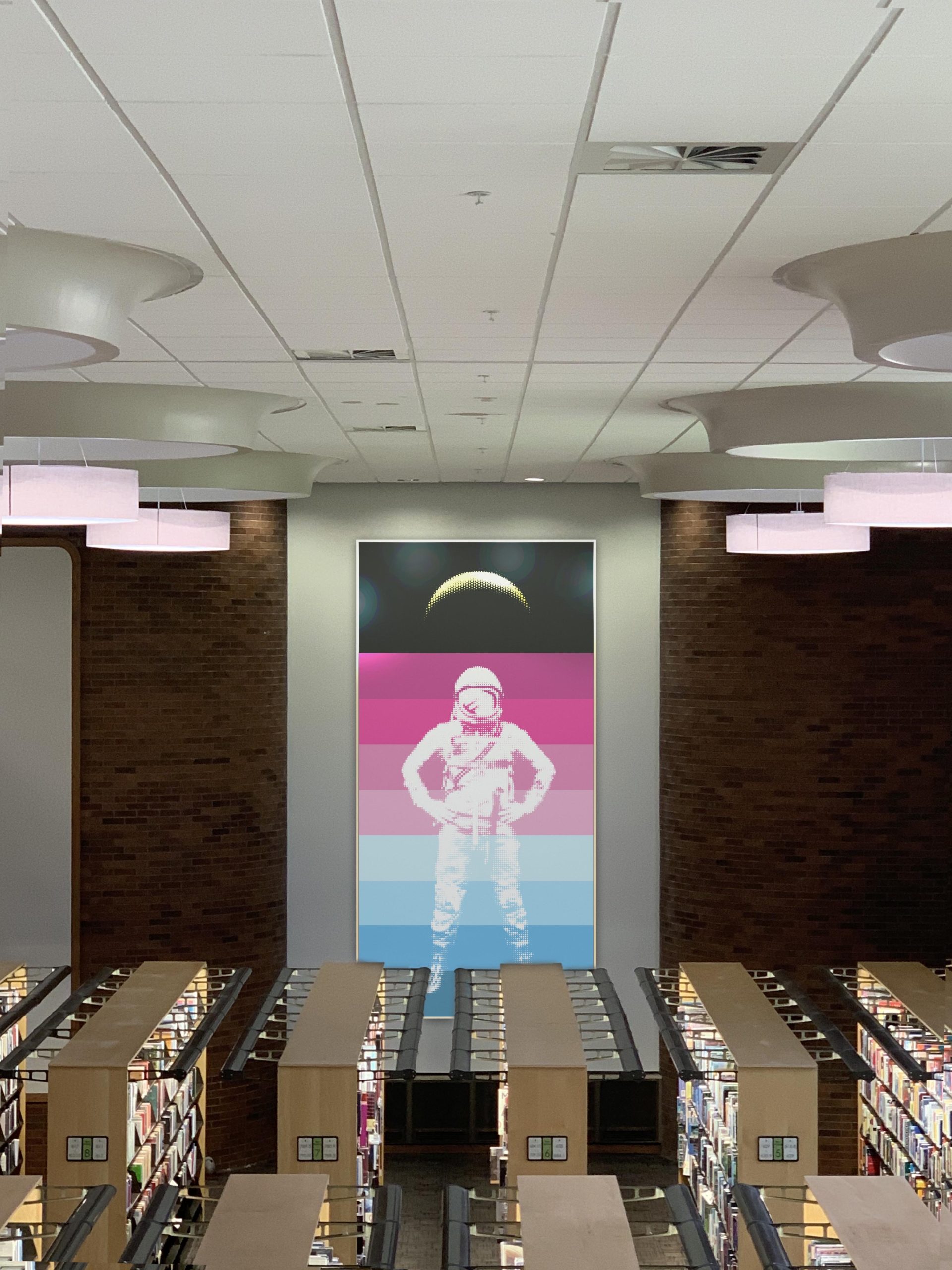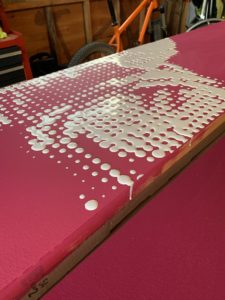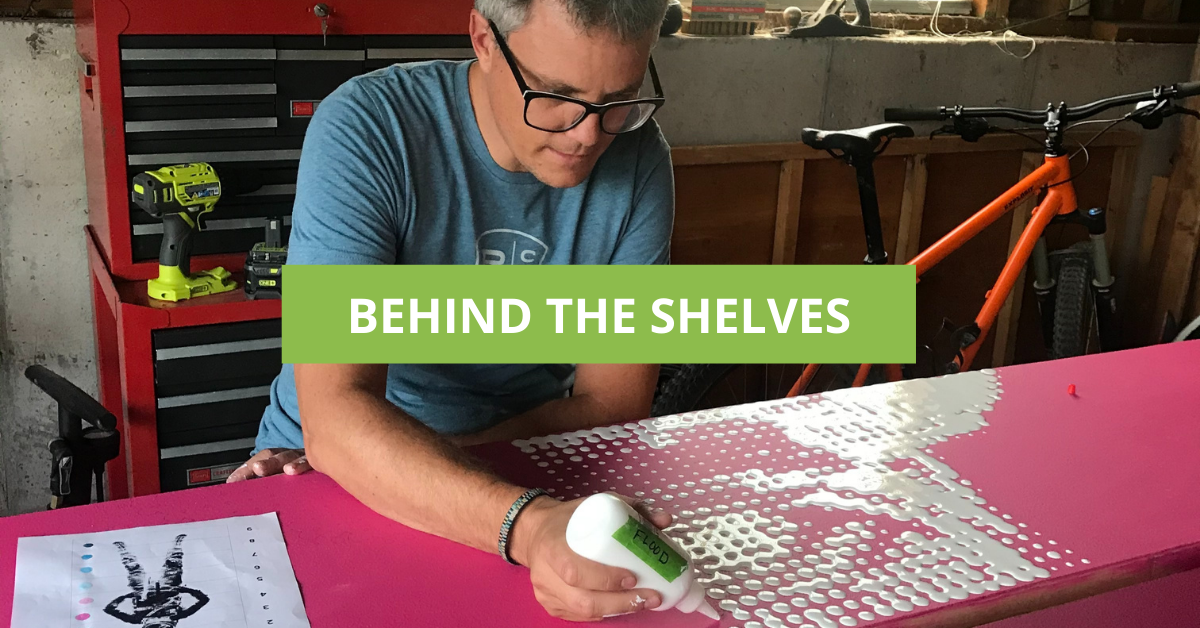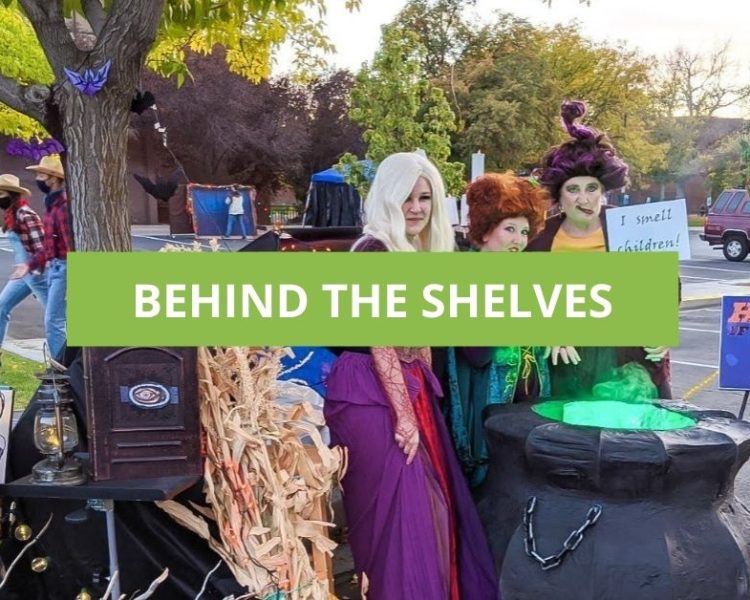
Dreamer, 2020
Acrylic and resin on panel.
Dreamer by Matt Shurtleff is the newest addition to the Orem Library’s art collection and a must-see on your next visit. This eye-catching, dramatic panel creation measures 16 feet high and 8 feet across and will be on permanent display in the library’s south wing. In an interview with Orem Library, artist Matt Shurtleff explained his process and ideas that went into his creation of Dreamer.
Orem Library Interview with Matt Shurtleff
What inspired you to create Dreamer? Why did you choose this art for the Orem Library?
Knowing the painting would be installed in the nonfiction section of the library, I wanted to create something that was rooted in reality and history, but also felt a bit forward-thinking. I was a kid growing up in the Space Shuttle era and riding a rocket into space really captured my imagination. I’ve been fascinated by space and everything to do with it my whole life, particularly the historical aspects of it. I own (legally!) a piece of foil from the Apollo 11 Command Module. A lot of my artwork deals with aspects of space travel in theme and aesthetics. I believe space exploration is a noble effort for humankind. It’s generally a peaceful effort. It pushes us to cooperate with other nations and to push the limits of what is possible. It’s fun to see so much interest in space exploration right now, especially with the advent of private space companies.
Is the astronaut based on a real person?

The astronaut in the painting is Walter “Wally” Schirra, who was one of the original 7 Mercury astronauts. It is from a photograph of him testing his Mercury space suit. When I look at the photograph, it feels posed, but also candid in a way. Wally looks straight into the camera with his hands on his hips, confident, as if to say “What’s next? Let’s rock!” It is much different from photographs of other astronauts at the time. These early guys were all top test pilots, very smart and honestly a little bit crazy; volunteering to sit on top of a bomb and be shot into space takes a bunch of courage and also a hint of recklessness and I think this is what draws me to them. There were so many unknowns. Calculations on orbital trajectories were done with a slide rule, not a computer. These guys and the teams that made them successful really wanted this, and they pushed through obstacles to make it happen.
Why did you choose these colors for Dreamer?
For a permanent large scale artwork in a public space, color can be tricky. Trends come and go and paintings can feel dated very quickly. I can tell you immediately if a mural was painted in the 70s, for example, just by the colors. I wanted this to have more longevity than that. I based it off of printer ink. The advent of CMYK in printers changed the way we work. Suddenly we could print a huge range of colors using four inks. It is so practical and anyone who has ever replaced ink cartridges on their home printer will recognize those colors. They represent innovation but also familiarity. Unless a new way to make one ink turn into anything you want (and I wouldn’t put it past us to figure that out), CMYK will most likely be around for a long time. The Cyan and Magenta panels have gradients of themselves, but it all follows that basic idea.
Tell us about your process. What materials and techniques did you use?

Part of the interest for me in doing big works like this is the planning and construction of how it will work. I knew I wanted to fill the space of the wall, but I also knew that a 16′ x 8′ painting would be very difficult to get to the west end of the hall once it was completed. Transport would be a big challenge. Brainstorming with my wife one night, she suggested doing multiple panels and I instantly knew she was right. I booted the cars from my garage and turned it into a studio for 3 months while I built and painted the wood panels. I then rolled the background colors on. I created the image of the astronaut in a design program on the computer and then drew the image on the panels in pencil. I chose to do a half-tone pattern—the dots you see when you look at a photo under a magnifying glass—to suggest all the different pieces of time and effort and people that it takes to make dreams a reality. I then put white paint with some flow medium in squeeze bottles and squeezed the dots out one at a time. When the paint was good and dry, I covered each panel with a flood coat of resin, which is how the super hard and shiny surface was achieved. It was messy and also pretty fun.
What is the role of art in the library? What do you hope this art makes people think about?
Reading educates, entertains, and helps cultivate new ideas. It allows us to escape for a moment and then come back to reality with a new perspective. The explorers of the future won’t just be test pilots. They will be artists, educators, scientists, diplomats, and so on. I imagine this painting as being an idea that could have sprung out of one of the books on the shelves. I wanted it to be large and a little loud—but not too much—to encourage big ideas and new thoughts on what is possible. The pink may be a little wild for older generations, but I am hoping it still resonates, especially with youth. I’m proud to have this work hanging in the Orem Public Library. Look up, and dream!
In celebration of Dreamer, keep an eye out for space-themed book and media displays around the library, including a poster series in the breezeway entitled “Destination Moon: The Apollo 11 Mission Poster Exhibition.” We hope you enjoy this spectacular and inspirational art next time you visit the Orem Library!




